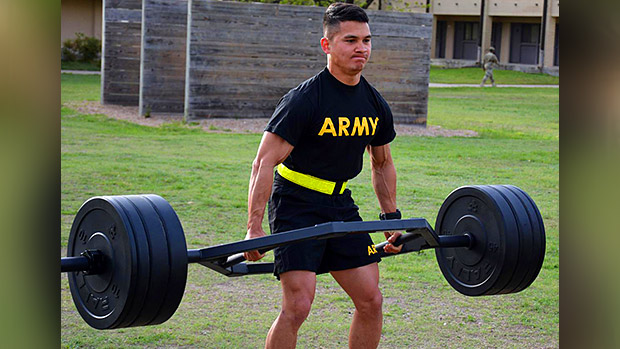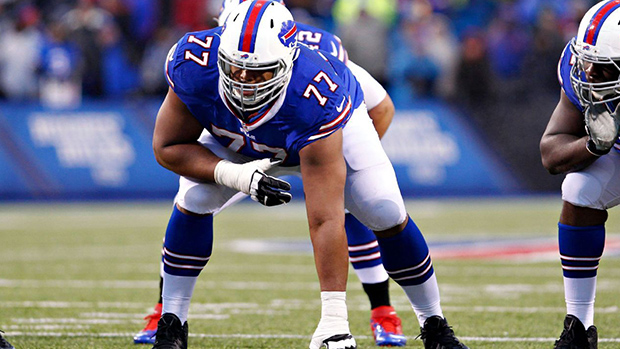APFT vs. ACFT
Since the early 1980s, the United States Army has been measuring the American soldier's physical readiness with the Army Physical Fitness Test (APFT). This test consists of a two-mile run for time, maximum number of push-ups completed in two minutes, and maximum number of sit-ups completed in two minutes.
The APFT is conducted during the soldier's initial entry/basic training and then at their unit every six months. The soldiers do this test collectively, usually at the platoon level (that's a team of about 30-50 soldiers). Diagnostic testing may also occur during deployments to combat zones and other countries, but these don't involve testing "for record."
The trouble is, the modern soldier needs to train and develop multiple aspects of fitness and performance, and the APFT doesn't reflect that. To be frank, the APFT doesn't reflect much of anything, but beginning in October, 2020, soldiers will instead be required to take the new Army Combat Fitness Test (ACFT).
This new test is a huge step in the right direction. The old APFT may have been logistically simpler to implement, but it lacked the testing of critical physical skills that the new ACFT measures: power, absolute strength, and anaerobic conditioning. Also, unlike the old APFT, the ACFT is gender neutral – there won't be different minimum standards for females or males.
Understanding specifically what the ACFT is testing will help soldiers understand how to train for it. And if you're not planning on enlisting, it would still be a "fun" way to test your readiness.
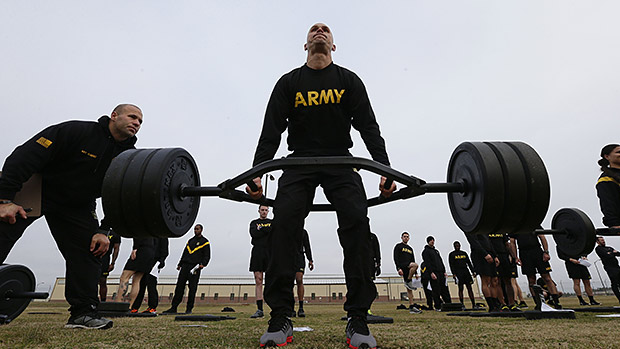
The ACFT has six events. The ACFT has six events. Let's use the requirements for soldiers in "heavy" physically demanding units or jobs, which may be more interesting to T Nation readers and lifters. To max the test, you have to score 100. To minimally pass the test, you have to score 70. Here's how to train for them:
1. Three-Rep Maximum Trap-Bar Deadlift: 2 attempts to establish a 3RM
- To score 100: 340 pounds x 3
- To score 70: 180 pounds x 3
This test is a display of your absolute strength. Bodyweight circuit training isn't going to cut it for this one! Being absolutely strong is a practical thing – picking up heavy artillery shells, throwing an M2 .50 caliber machine gun over your shoulder, or climbing over a wall while wearing 100 pounds of kit and body armor isn't going to happen without some raw strength. You're going to need to spend time in the gym lifting weights... heavy weights.
2. Standing Power Throw: 10-pound medicine ball thrown over and behind the head
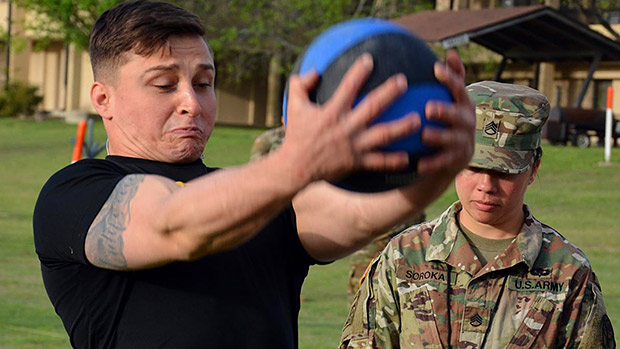
- To score 100: 13.5 meters
- To score 70: 8.5 meters
Throwing a grenade, jumping over a ditch, tossing an ammo can to the gunner, kicking down a door – all of this requires the ability to generate force with high velocities. You need to be explosive and violent. Sharpening your reflexes and focusing on plyometrics and a few weighted movements are going to be your best bet – things like different varieties of jumps, throws, slams, swings, and Olympic lifts.
3. Hand-Release Push-Ups: as many as possible in two minutes
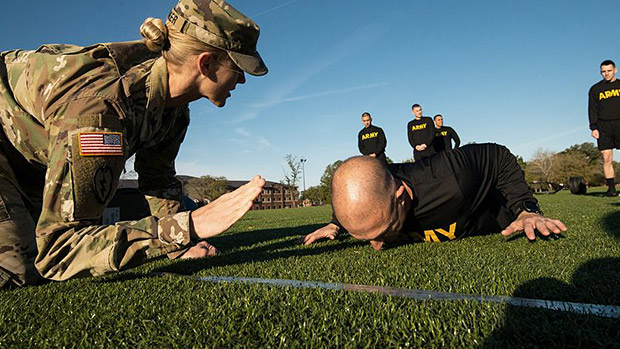
- To score 100: 70
- To score 70: 30
If the soldier already has a level of general, absolute strength, then this event will be a test of muscular endurance. However, when a soldier is extremely weak, this becomes a test of their strength, and soldiers need to train accordingly.
4. Sprint, Drag, Carry: Sprint 25 meters, drag a 90-pound sled 25 meters, side shuffle 50 meters, and carry two 40-pound kettlebells 25 meters, all for time

- To score 100: 1:40 min.
- To score 70: 2:09 min.
This is a new form of conditioning for the Army, yet it's the most representative of what soldiers might see on a battlefield: sprinting to cover, dragging your buddy to safety, carrying ammunition 50 meters to the front.
This test requires anaerobic conditioning, so being a good distance runner isn't going to cut it. You need lots of muscle and lots of stored glycogen. Development of this type of conditioning requires a combination of "resisted" training like farmers walks, yoke carries, sled drags/pushes, and buddy/log carries, along with "unresisted" training like various sprints and bear crawls.
5. Leg Tuck: Hanging From Pull-Up Bar (knees to elbows)

- To score 100: 20 reps
- To score 70: 5 reps
Like the hand-release push-up, the leg tuck is going to be an endurance test for some and a strength test for others. Generally speaking, the smaller guys are going to see this as endurance training whereas the big boys will have to look at this as part of their strength training.
6. Two-Mile Run for Time

- To score 100: 12:45 min.
- To score 70: 18:00 min.
Everyone who hates to run pulls the old "I'll never need to run for two miles in combat" card, but they're missing the point. This test evaluates aerobic capacity: overheat and seize up, or run cool and efficient under high stress and nasty hot weather.
I've seen plenty of big boys drop out as heat casualties while their weaker, yet longer-distance running counterparts kept chugging along in temperatures of 145 degrees.
There needs to be a healthy balance.
This type of aerobic conditioning can be broken down into two categories, similar to the sprint, drag, and carry drill. Do "unresisted" aerobic training with long, slow distance runs, and do "resisted" aerobic training with ruck marches in full kit or a litter-carry run.
The best approach to training is to create training slots that are themed for each aspect of performance. That allows you to stay organized while forcing the body to adapt.
A common mistake is to "cross contaminate" the different performances in an attempt to make it harder. Unfortunately, when it comes to adaptation, all this is doing is robbing Peter to pay Paul. Keep the cross-training to a minimum and focus on development.
Here are the training themes you'll need to hit:
- Strength: Hit the weights. Heavy, low reps, long rest periods.
- Power: Agility drills and plyometrics.
- Anaerobic conditioning: Resisted and unresisted.
- Aerobic conditioning: Long distance running, biking, and rowing.
- Muscle endurance: Bodyweight circuit training.
With the organization established, it's time to define who you are. Does a light infantryman need to be trained like a heavy mechanized artilleryman? No. So I've provided two basic breakdowns, the first for the soldier that needs a conditioning bias and the second for the soldier who needs a strength bias.
Both will get you to pass the ACFT with flying colors, but more importantly, choosing the one appropriate for your role will get you in the shape you truly need to be in to fulfill your warrior duties.
Day 1 – Strength and Muscle Endurance
- The majority of this day should be spent on barbell movements: squats, deads, rows, and pressing – 4-6 sets of 4-6 working reps.
- Save 10 minutes at the end for an aggressive bodyweight circuit smoke-session.
Day 2 – Aerobic Conditioning
- Long slow-distance running.
- The priority is time and distance, so you don't have to smoke yourself on this run. Just go for a 30-40 minute solid run.
- Alternate this run every other week with a resisted aerobic session: ruck march in full kit or a litter-carry run.
Day 3 – Anaerobic Conditioning
- 30-45 minutes of sled pushing, carries, and sprints will be plenty of work. Don't kill yourself.
Day 4 – Power and Strength
- Warm up with some agility drills, jumps, slam balls, and throws. This will train power, summon aggression when you need it, and set the tone for another heavy lifting session.
- Now repeat the lifts from Day 1 (4-6 sets of 4-6 reps of squats, deads, rows, and presses).
Day 5 – Conditioning of Choice
- What's your weakness? Are you a scrawny guy? Anaerobic conditioning (sled pushing, carries, etc.) is going to be your best bet. Big and strong? Go out on a good run or ruck march.

Day 1 – Power and Strength
- Weighted plyometrics and Olympic lifts to develop your specific power: 4-6 sets of 2-3 reps.
- Focus on the big barbell lifts for the strength-training portion of your day: 4-6 sets of 4-6 reps on squats, deads, rows, and presses.
Day 2 – Anaerobic Conditioning
- 30-45 minutes of sled pushing, carries, and sprints (artillery shells aren't going anywhere on their own and they aren't going to get any lighter).
Day 3 – Strength
- The majority of this day should be spent on barbell movements: squats, deads, rows, and pressing: 4-6 sets of 4-6 working reps.
Day 4 – Aerobic Conditioning
- Focus on long, slow runs. As a mechanized guy, you probably aren't going to do many ruck marches.
Day 5 – Strength and Endurance
Save 10 minutes at the end of your training session for an aggressive body weight smoke-session. As an example, do a few rounds of the following circuit for 10 minutes:
- 10 Inch-worms
- 20 Push-ups
- 20 Prone rows
- 30 Air squats
- 40 Sit-ups
This is the last training day of the week, so leave it all out there.
The Army is trying to make a new soldier. Don't get left behind. Get organized, get focused, train hard, and become the modern super soldier.

